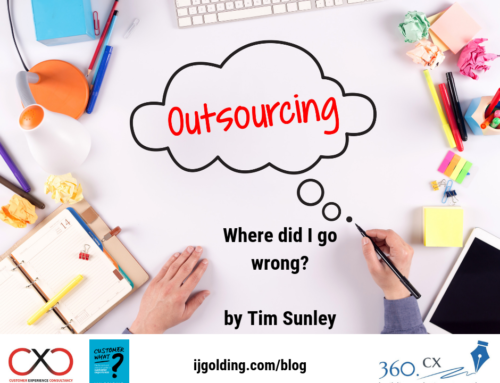
In last month’s column, I asked the question, ‘Are you a Leader or a Follower?’ The question was a precursor to defining why Customer Experience needs good, strong leadership. You will need to read the article to determine if you agree! This month, I want to ask three connected but altogether different questions:
- What do you do if the organisation you work for or with does NOT have strong customer focused leadership?
- How can followers become leaders in that case?
- How can a CEO become a stronger customer focused leader, assuming he or she realises the need and is willing to try?
All too often, I and people in my networks are interacting with people in leadership roles who are not demonstrating what it really means to be a leader. Not only are they failing to influence their people to understand what it is they stand for; and what it is they should be following; they are also failing to invest in developing and maintaining the required ‘ecosystem’ to enable success for ALL stakeholders – the customer, the employee and the shareholders AS WELL AS themselves.
I use the word ‘ecosystem’ intentionally. According to various dictionaries, the general meaning for this word in a business context is, ‘a complex network or interconnected system’. Any capable or effective leader should constantly be investing in the development of the ecosystem that surrounds them – with the right people, skills, behaviours and collaborations – the best leaders in the world are not afraid to surround themselves with people and networks that are even more capable than them.
There is no better description of this than Jim Collins excellent and renowned perspective on ‘Level 5 Leadership’:

There are painfully few Level 5 leaders on our planet. To get there, it is necessary for a leader to have developed the other four levels. By Level 3, a leader is already building their ecosystem – by Level they are mobilising it to achieve results – by Level 5 they are able to rely on the ecosystem to look after itself.
Why do so few leaders make it to Level 5 – or seem to be unable to get there? The answer is perhaps explained by something I heard a friend and fellow CX Professional, Craig Lee, say at an event celebrating CX Day in Dubai last month.
“Leaders talk about developing an ‘ecosystem’, but too many of them are spending almost all their time investing in their own personal ‘egosystem’!”
It is fair to say that this statement resonated rather strongly with the audience. Whilst it could be considered a rather facetious comment, it is interesting that almost everyone in the audience seemed to agree. It does appear that too many people who are in leadership roles are too focused on their own personal gain, rather than the good of the entire organisation.
Let me bring us back to the three questions I posed at the beginning of this post:
1. What do you do if the organisation you work for or with does NOT have strong customer focused leadership?
This is a more common scenario than those who are fortunate enough to be immersed in a customer focused environment. However, even if you are in this situation, not all hope is lost. To be a committed Customer Experience Professional, you must be driven to doing what is right for the organisation – even if your leaders are seemingly at odds with this. If you are going to succeed, then you MUST be prepared to leave all emotion at the front door of the workplace and operate in a world based on hard, cold, facts.
Customer Experience is a fact-based methodology. If leaders are more interested in massaging their egos, than dealing with the truth, then it is important to make the truth plain for all to see – not in an insensitive, ‘bull at door’ manner – but in a constructive, sensitive, empathetic manner. I do not want readers to think that I am suggesting many non-customer centric leaders are bad people – to the contrary.
Yet for a leader who may be more interested in personal gain, rather than the collective benefit of all stakeholders, it is important to help them understand how being more customer centric WILL benefit them AND everyone else. Allowing a leader to understand what customers and colleagues really ‘feel’ and ‘think’, without humiliating, or embarrassing them, but highlighting how they can seize on opportunities to benefit from changing things, can help to change the tide.
2. How can followers become leaders in that case?
However, where strong, customer focused leadership is lacking, it is often important to invest more attention lower down the organisation than at the very top. Many of the ‘follower’ community in companies that lack vision, direction and any sense of leadership, need to be given the confidence to drive customer centric change themselves – from the bottom up.
Very often, from middle management downwards, the overt passion, enthusiasm and desire to put people first (both customers and colleagues) is almost palpable. However, until people are given the belief – until a fire is lit – that makes them realise they do NOT need to wait for permission to do the right thing, they are at risk of ambling along in a variety of different directions.
I have always said to members of teams I have managed and Customer Experience Professionals I have mentored – if you are doing the right thing for the right reason – what have you go to lose? It takes courage to be a leader – and I strongly believe if you are able to unlock the backbone that exists in all followers, they will have the belief to do amazing things that have a tangible effect on themselves, the customer and the whole organisation.
3. How can a CEO become a stronger customer focused leader, assuming he or she realises the need and is willing to try?
Being a CEO is not easy – I say that as a CEO of a tiny business!! I can only imagine how difficult it must be to have the weight of shareholders, media, employees, customers, investors and sometimes even governments on your back – all the time. However, if IO take you back to Jim Collins model, to be a Level 5 leader would mean that you have personal humility and professional will.
To become a stronger customer focused leader, it is necessary to acknowledge that you do NOT know everything. It is necessary to surround yourselves with others who may have the answers you do not. It is necessary to listen – and listen regularly – to your people and your customers. It is necessary to admit when the wrong decisions have been made. It is necessary to demonstrate to your people that you believe they CAN do what is right. It is necessary to let your people know that you TRUST them. It is necessary to make it abundantly clear what you want the organisation to achieve AND what you expect from everyone in it. It is necessary to recognise people when they do great things. It is necessary to coach and guide people when they need to develop – not to chastise them when they make mistakes. It is important to let your people take the lead – as much as it is to show them the way in the first place.
I am sure you can add to this list or ‘necessary’ things – please feel free to do so by commenting on this article. It may also be prudent to share it with leaders in your network – especially those who may be investing too much in their ‘egosystem’, rather than the organisational ecosystem!
This post was originally written exclusively for my column on CustomerThink – a global online community of business leaders striving to create profitable customer-centric enterprises. The site serves 80,000+ visitors per month from 200 countries.
You can read my column here!







Leave A Comment